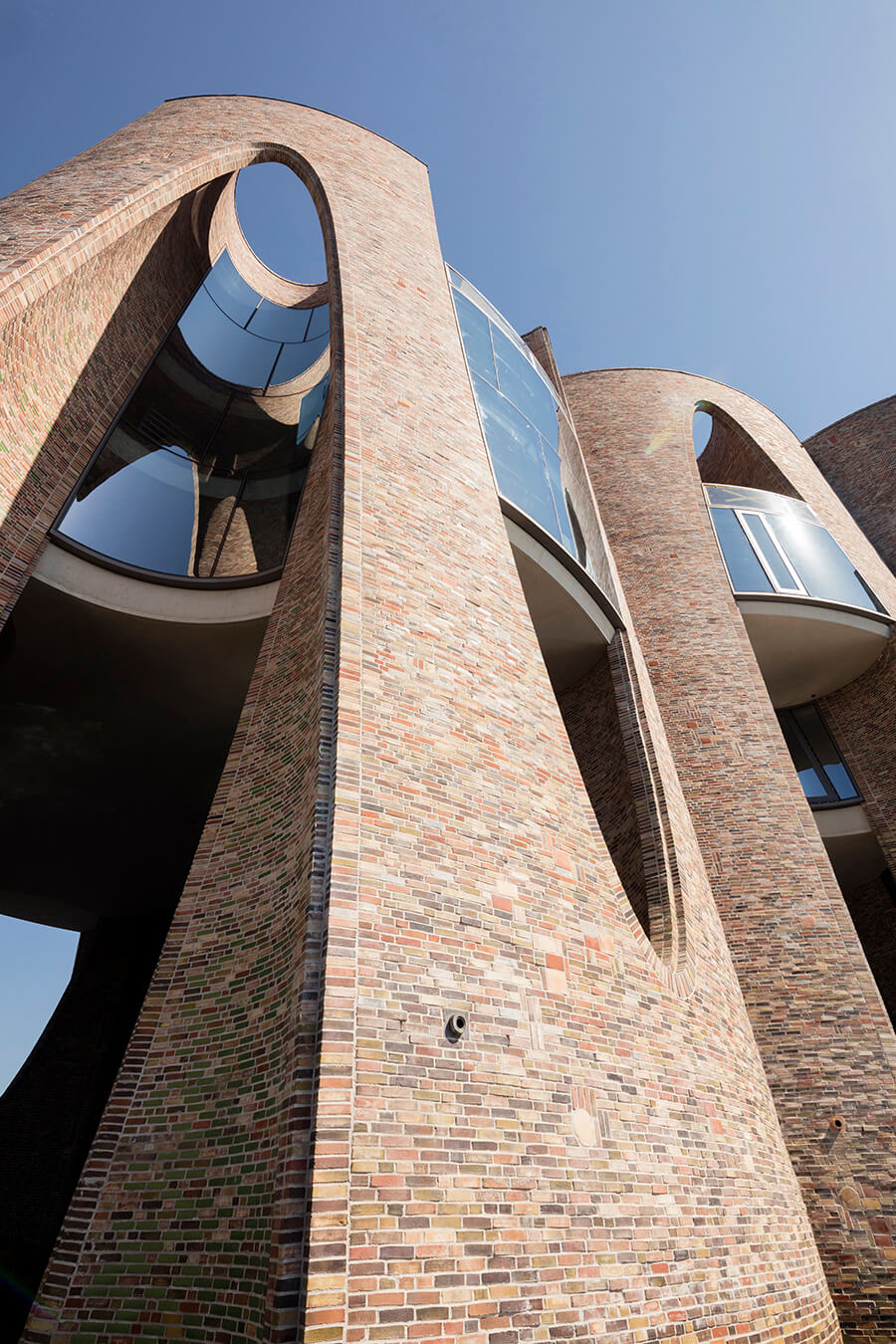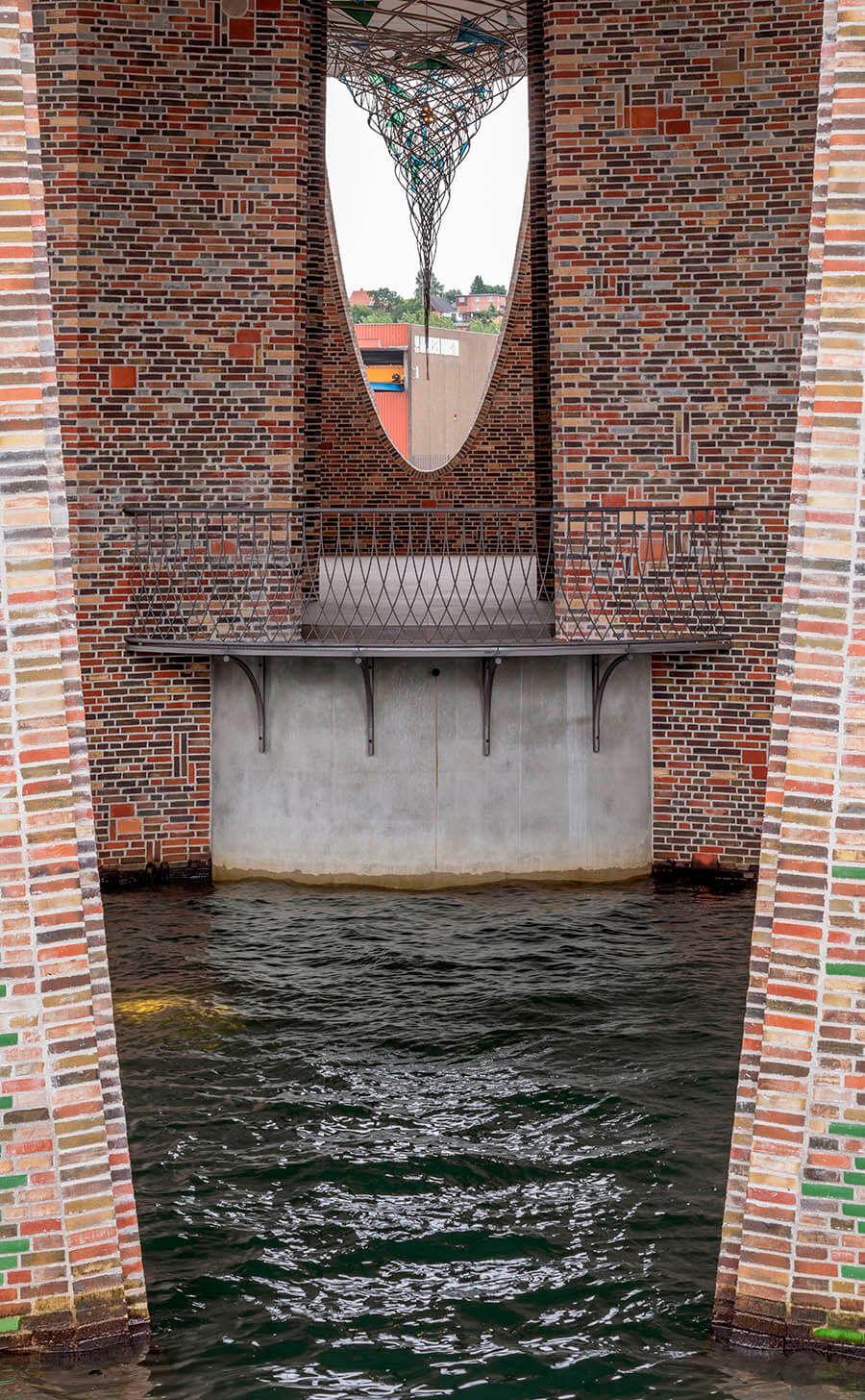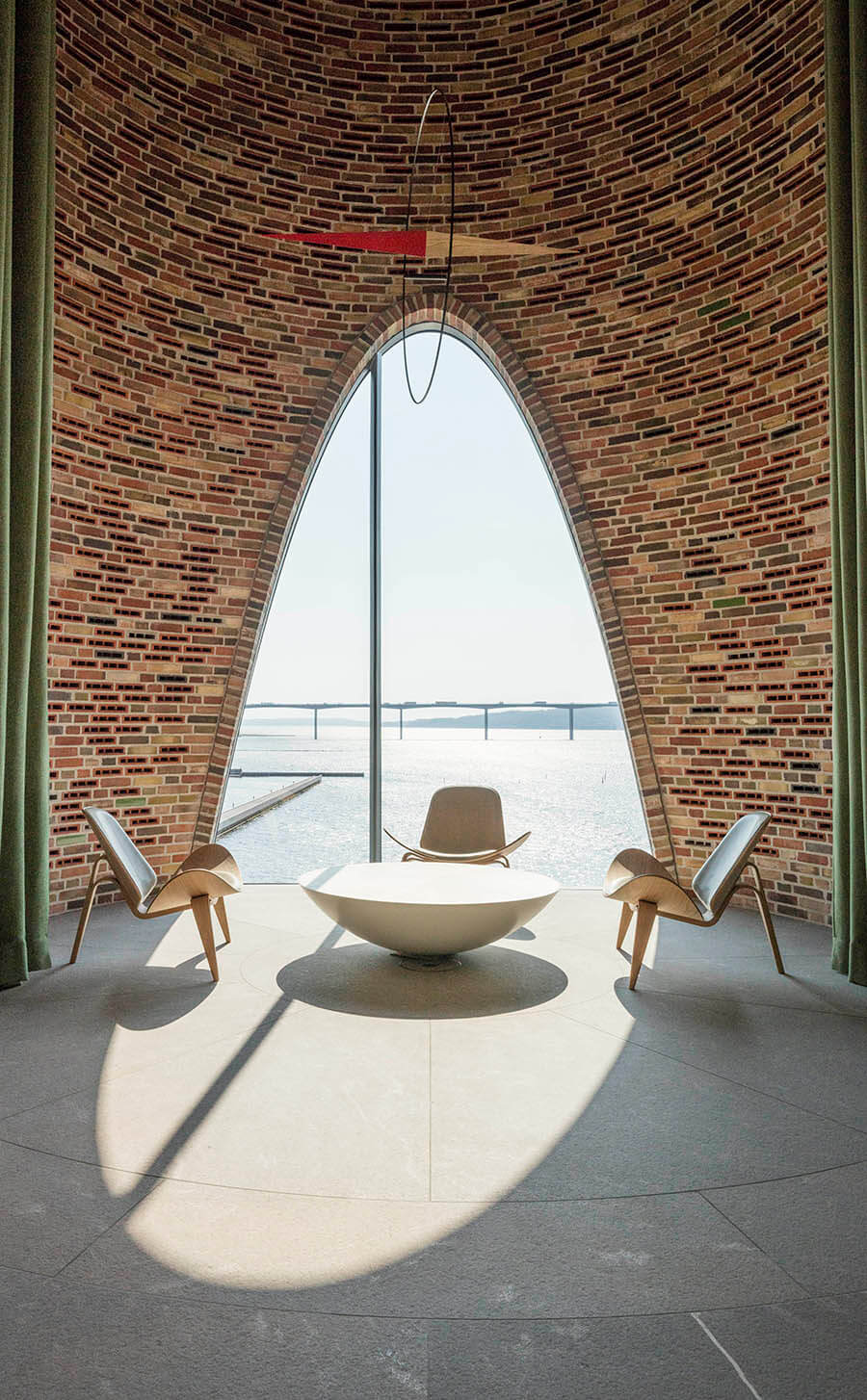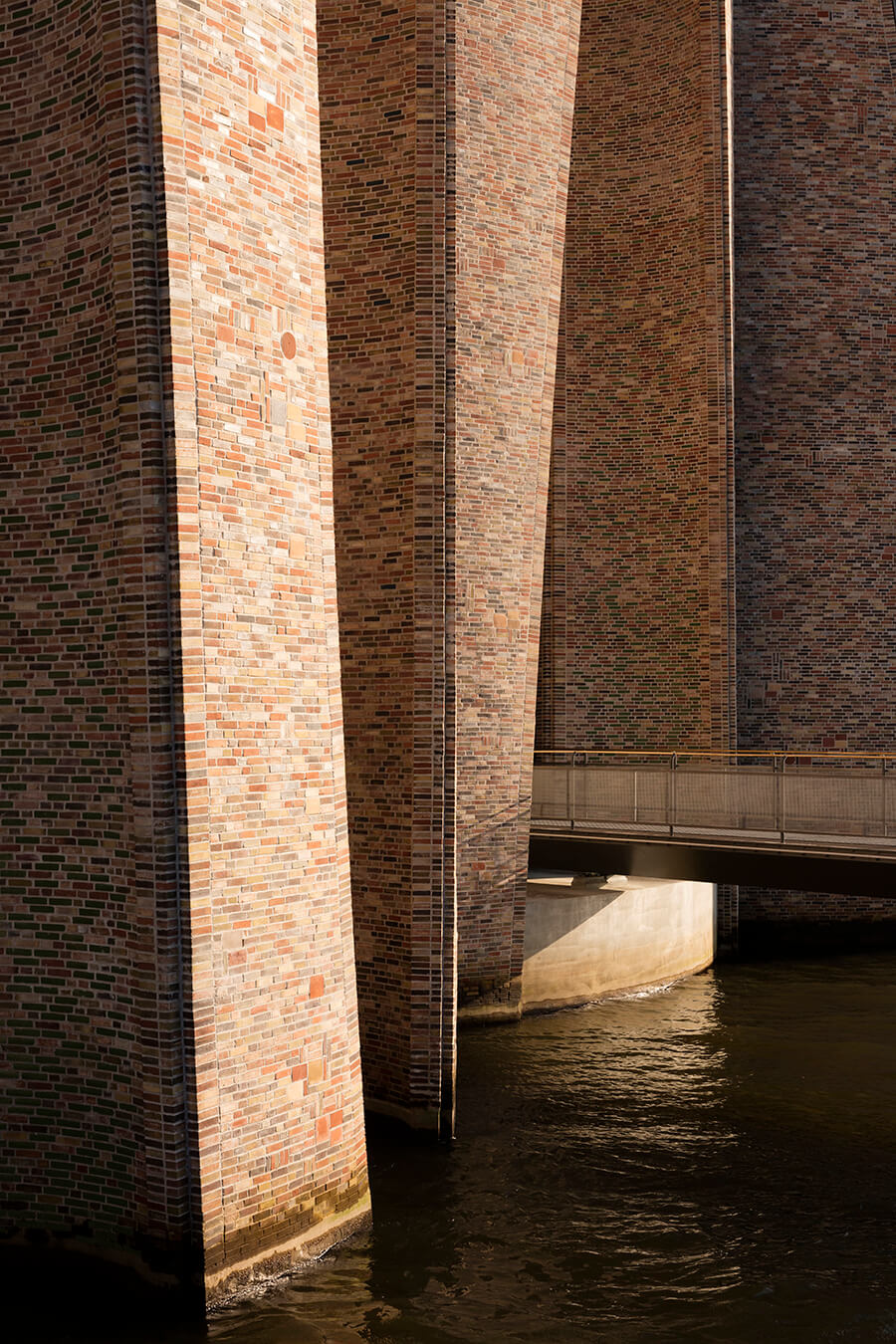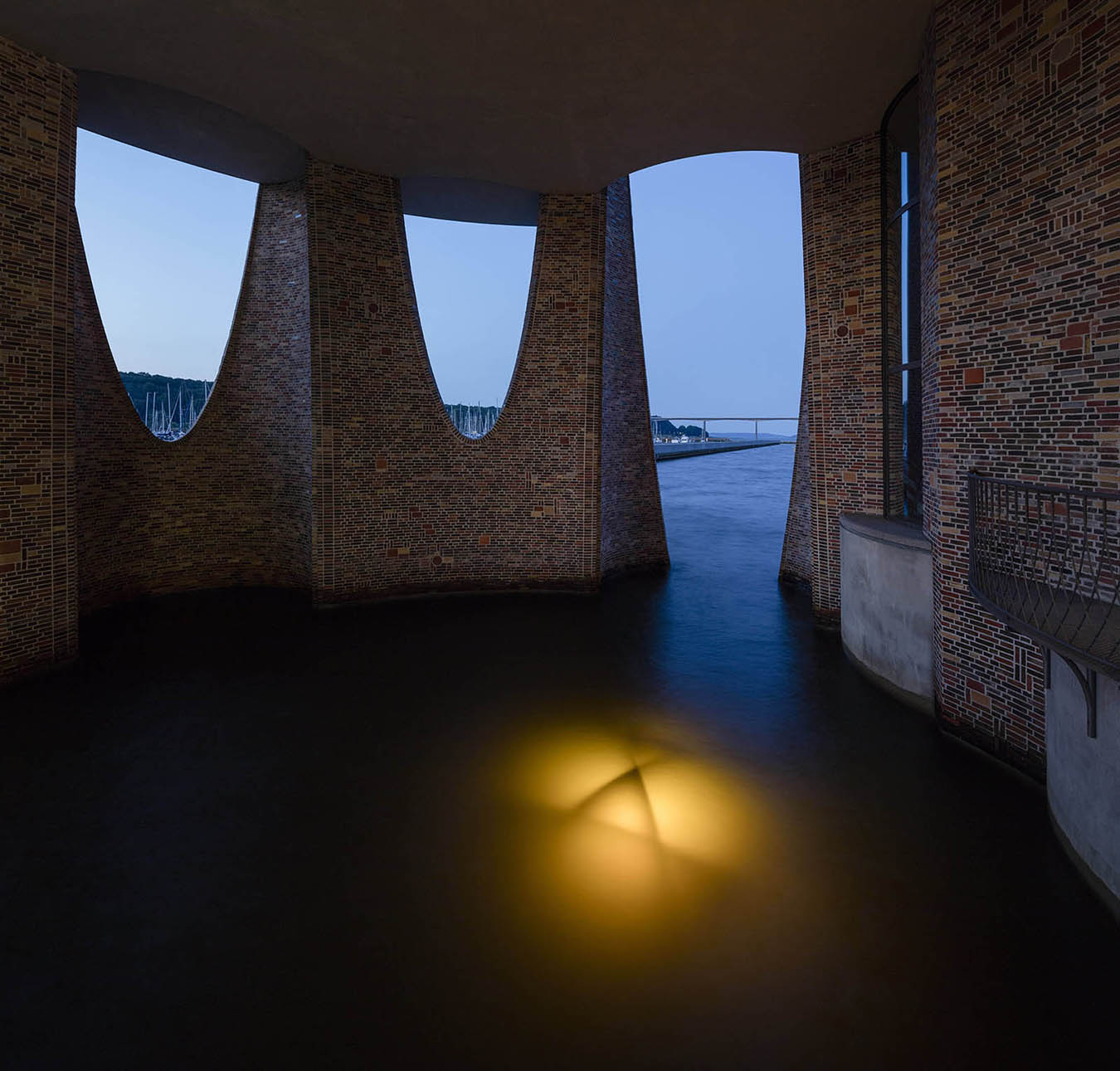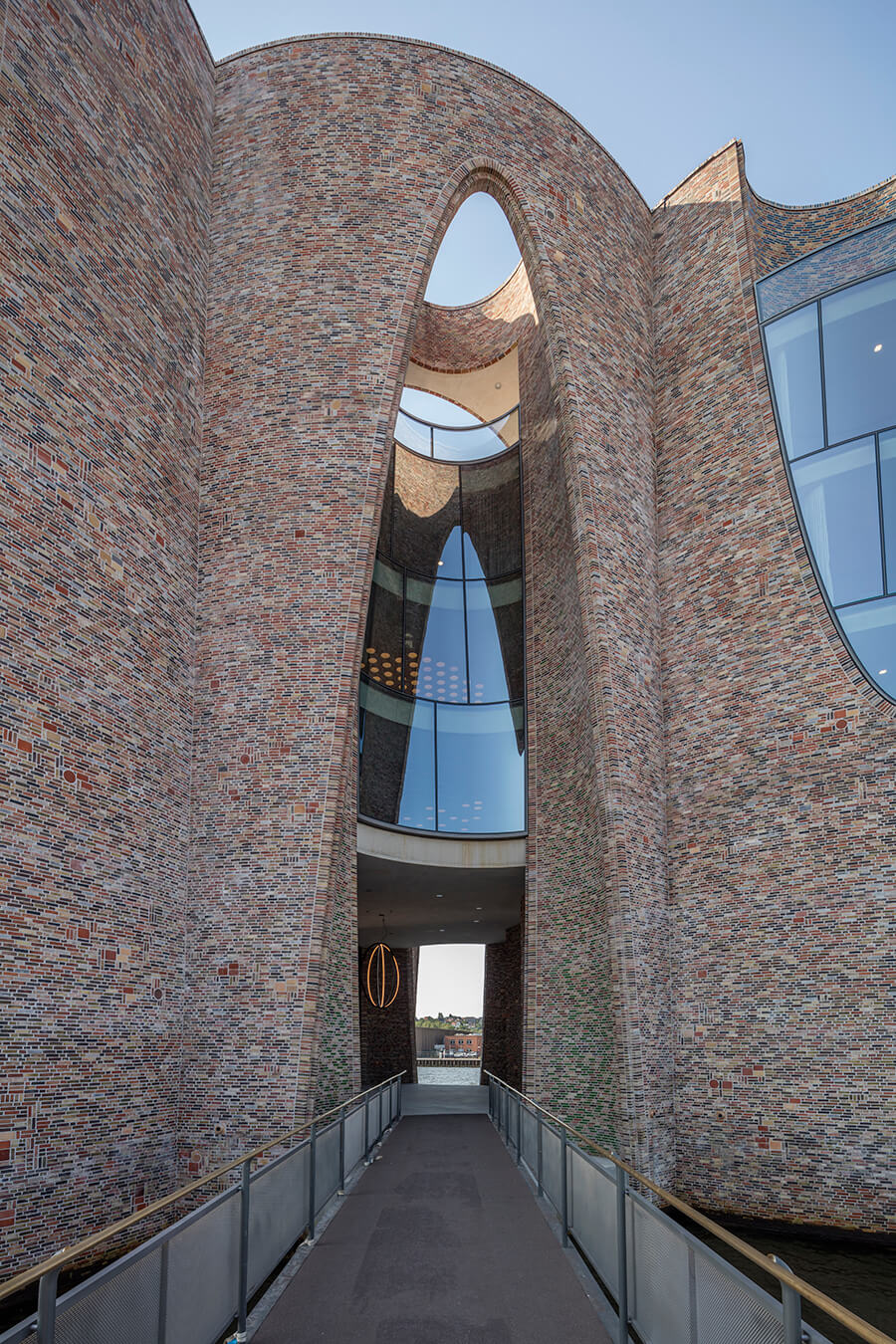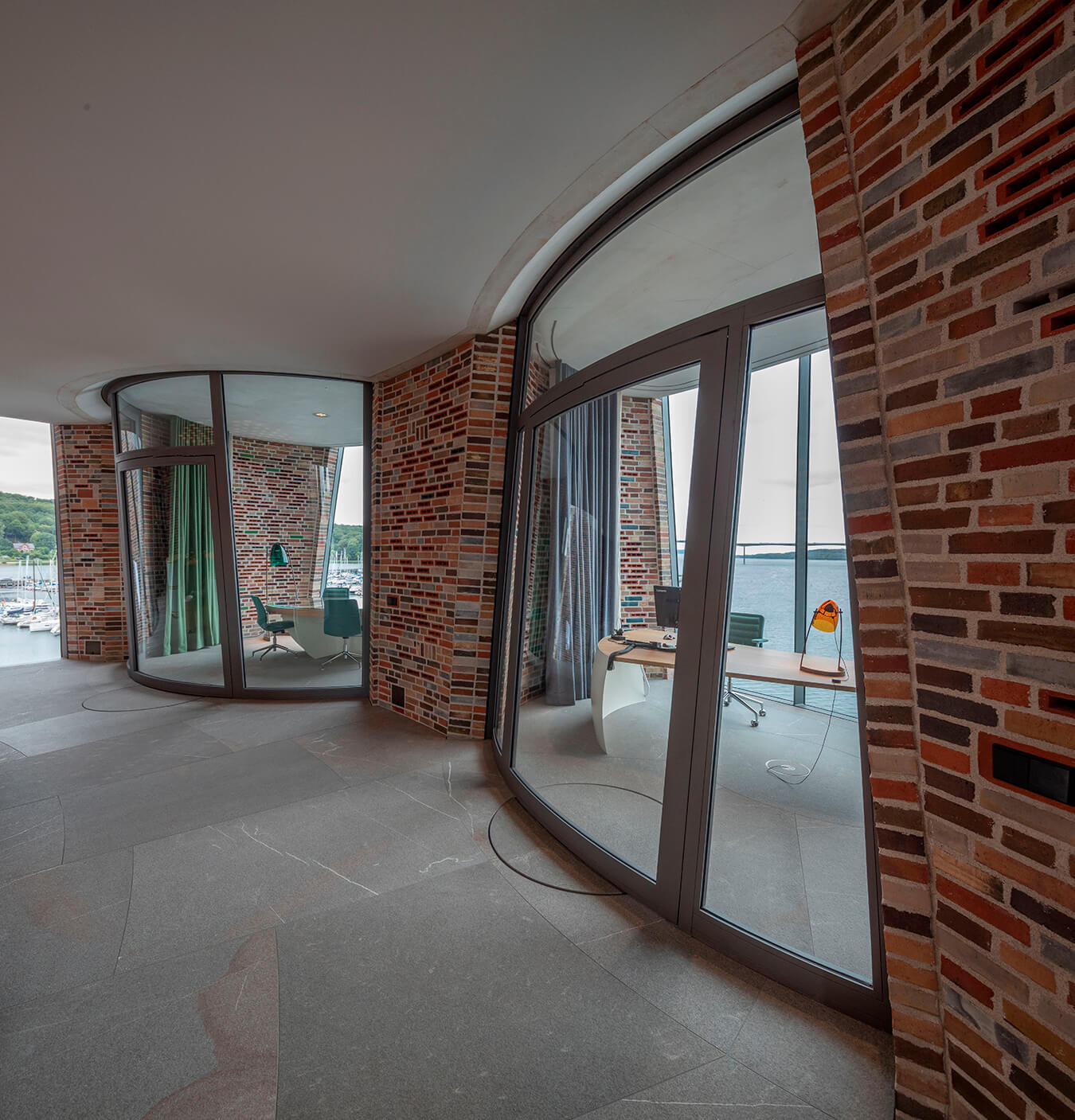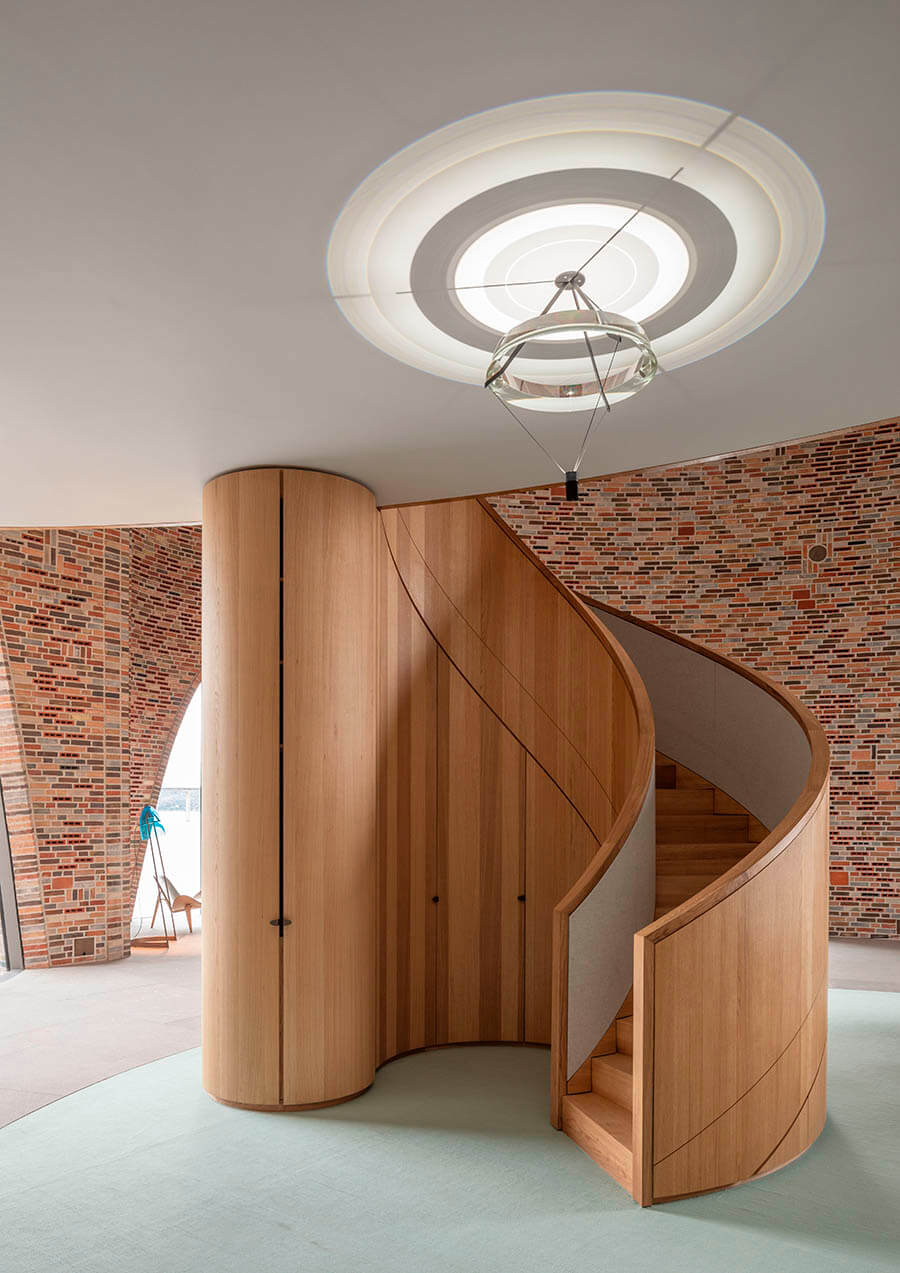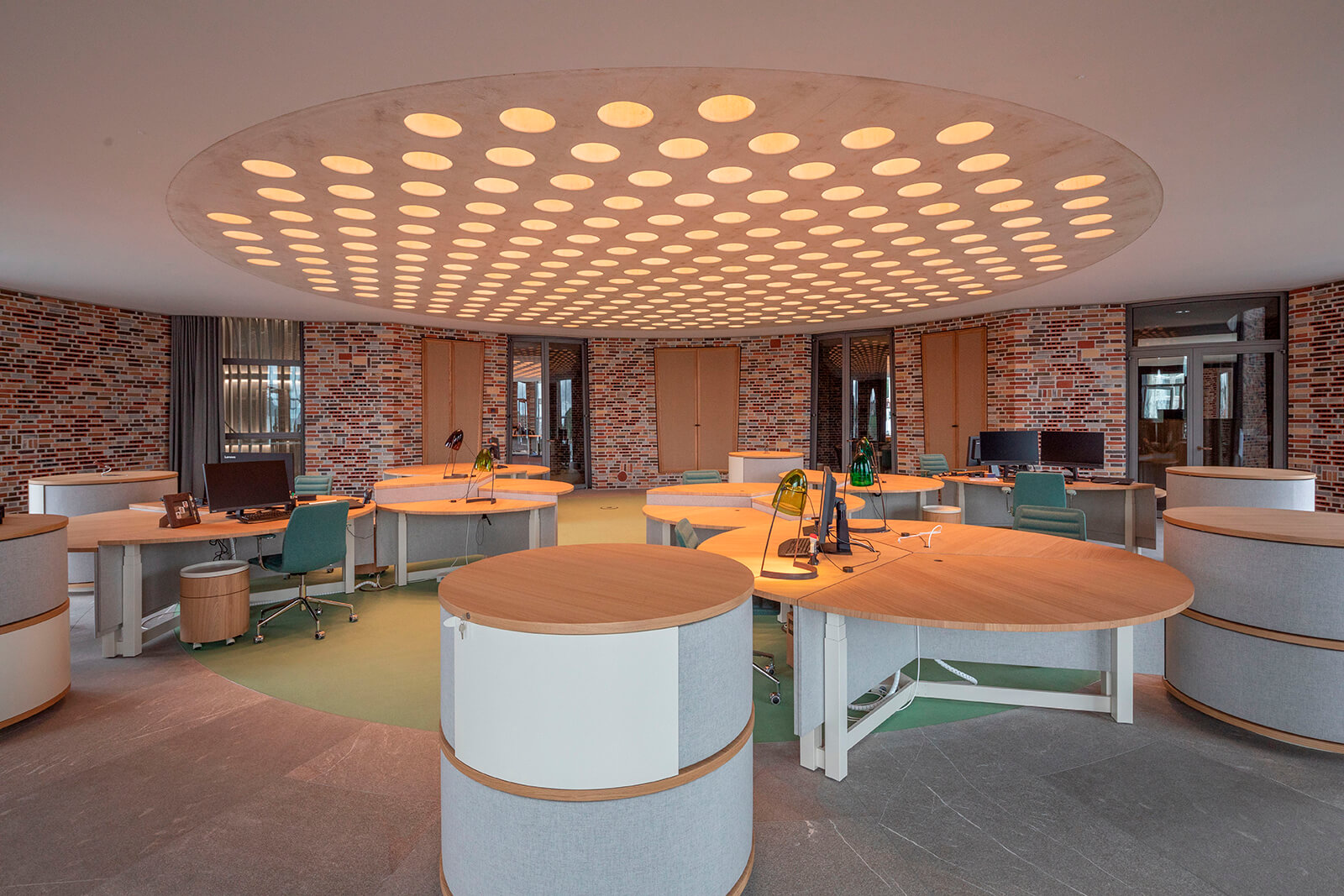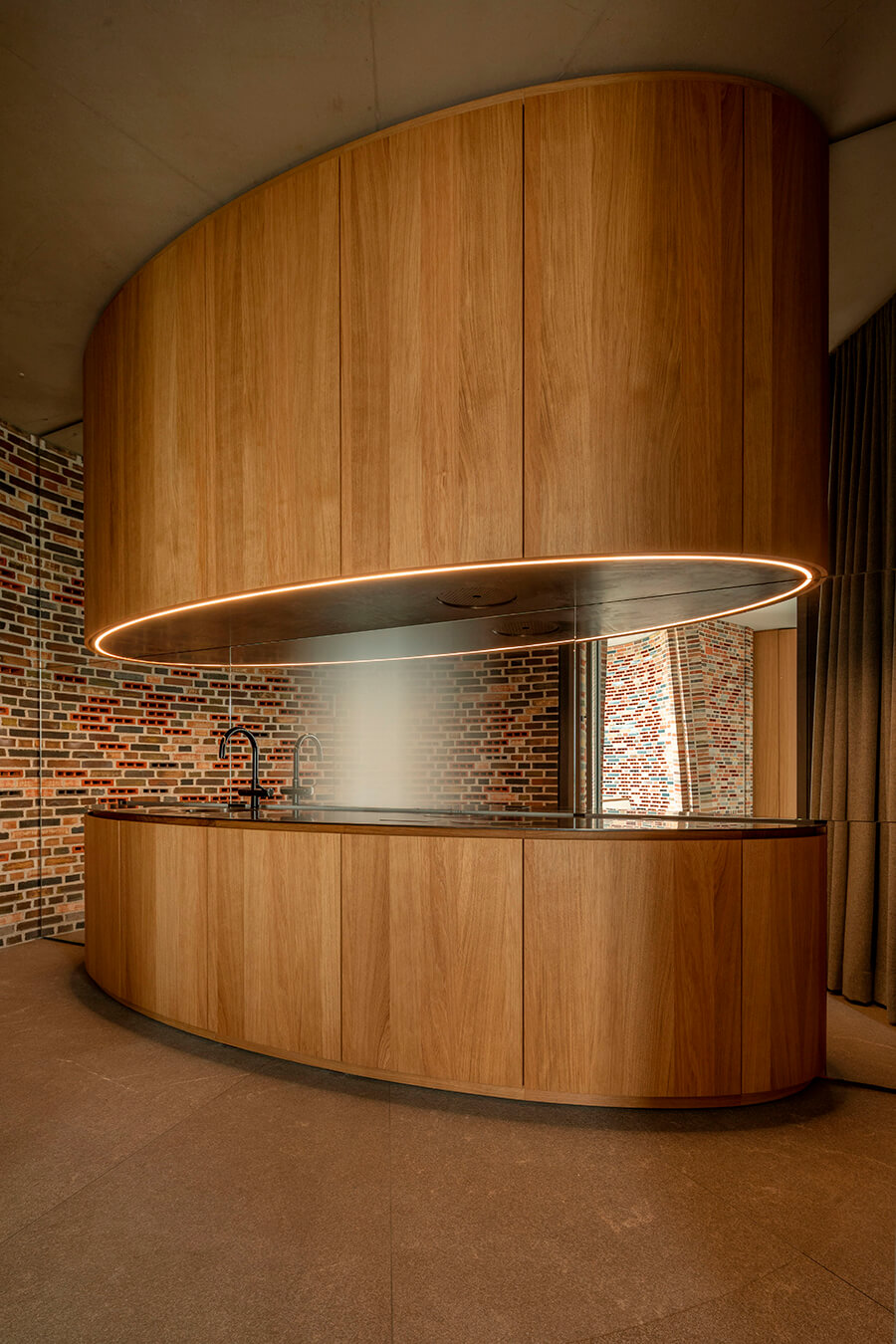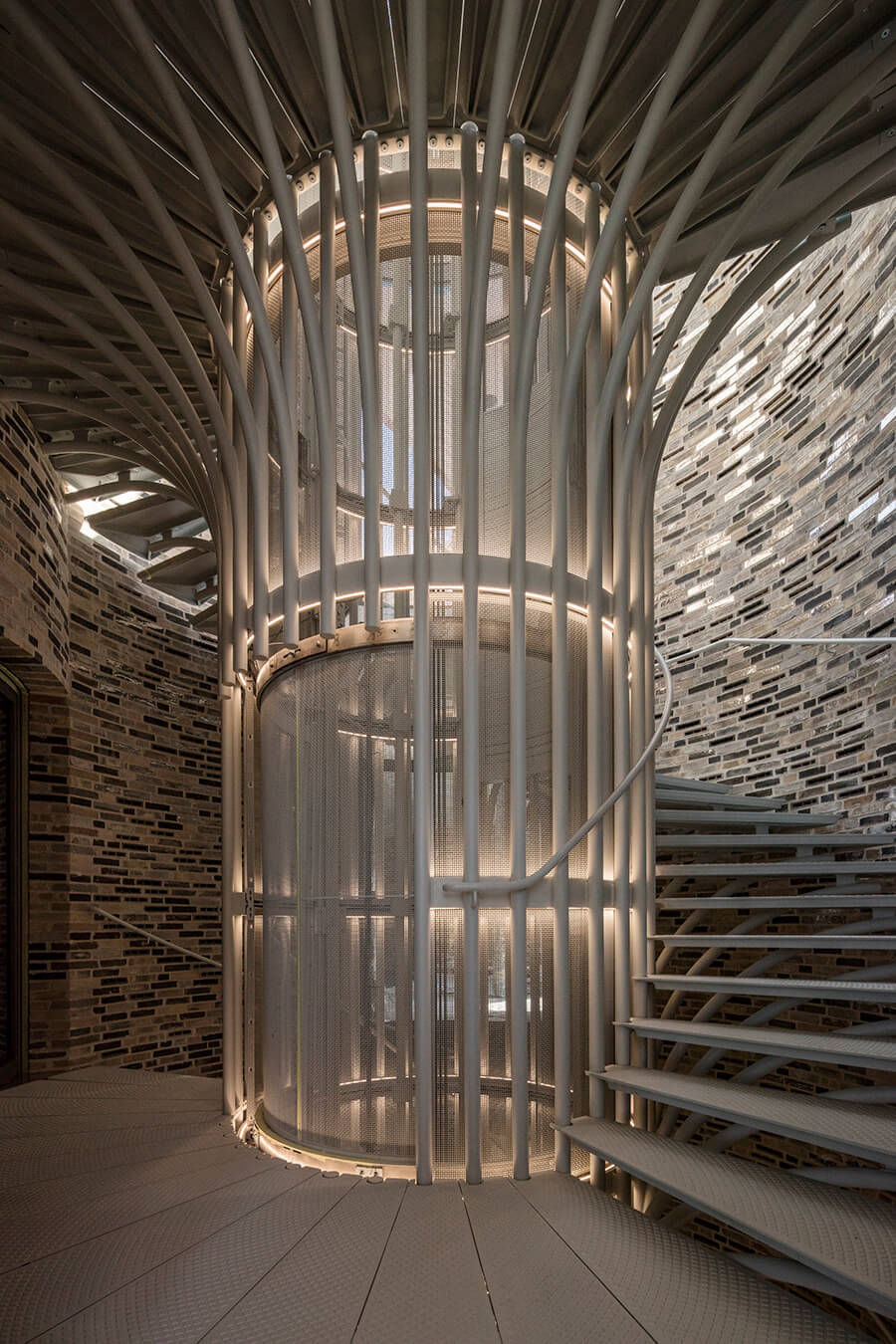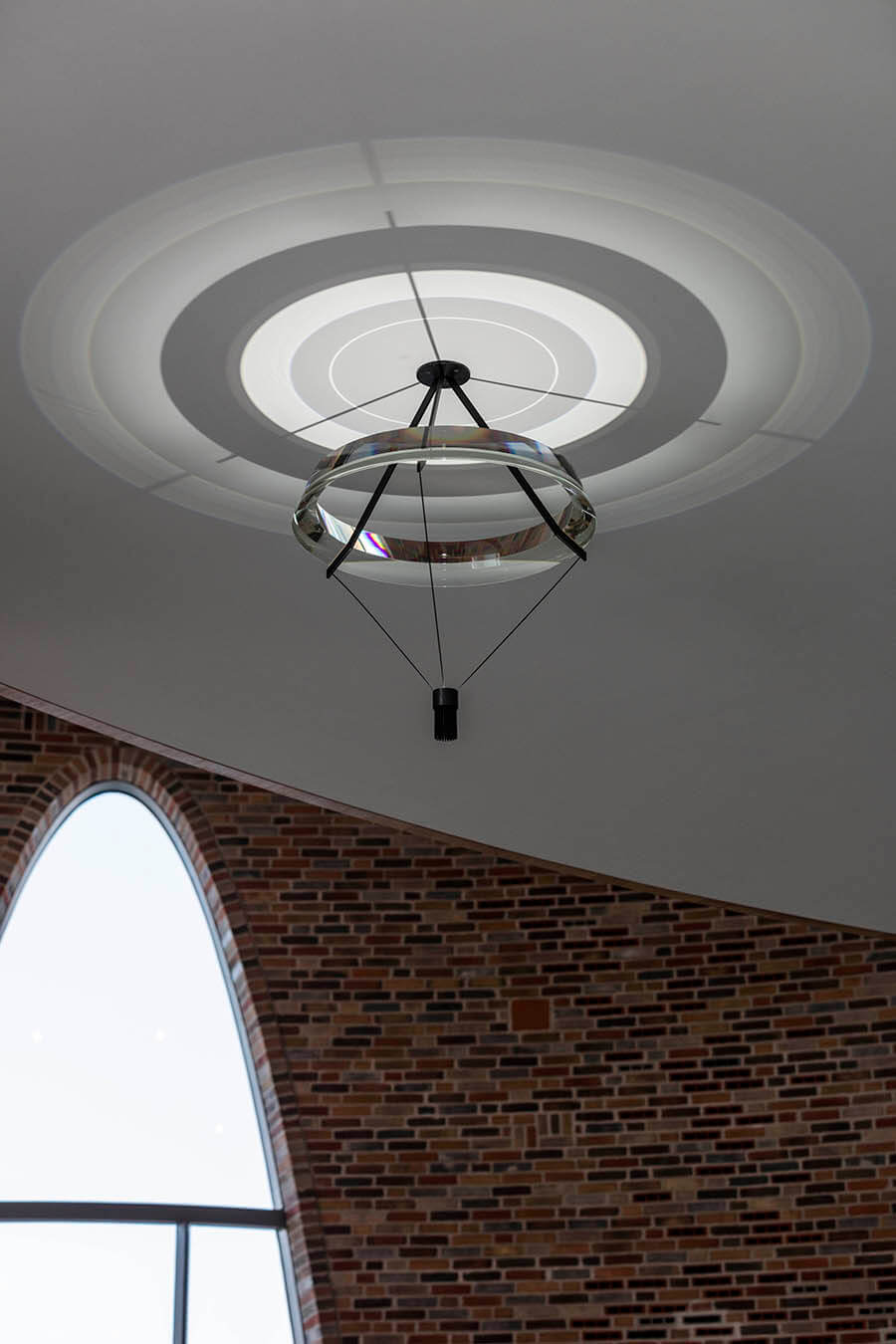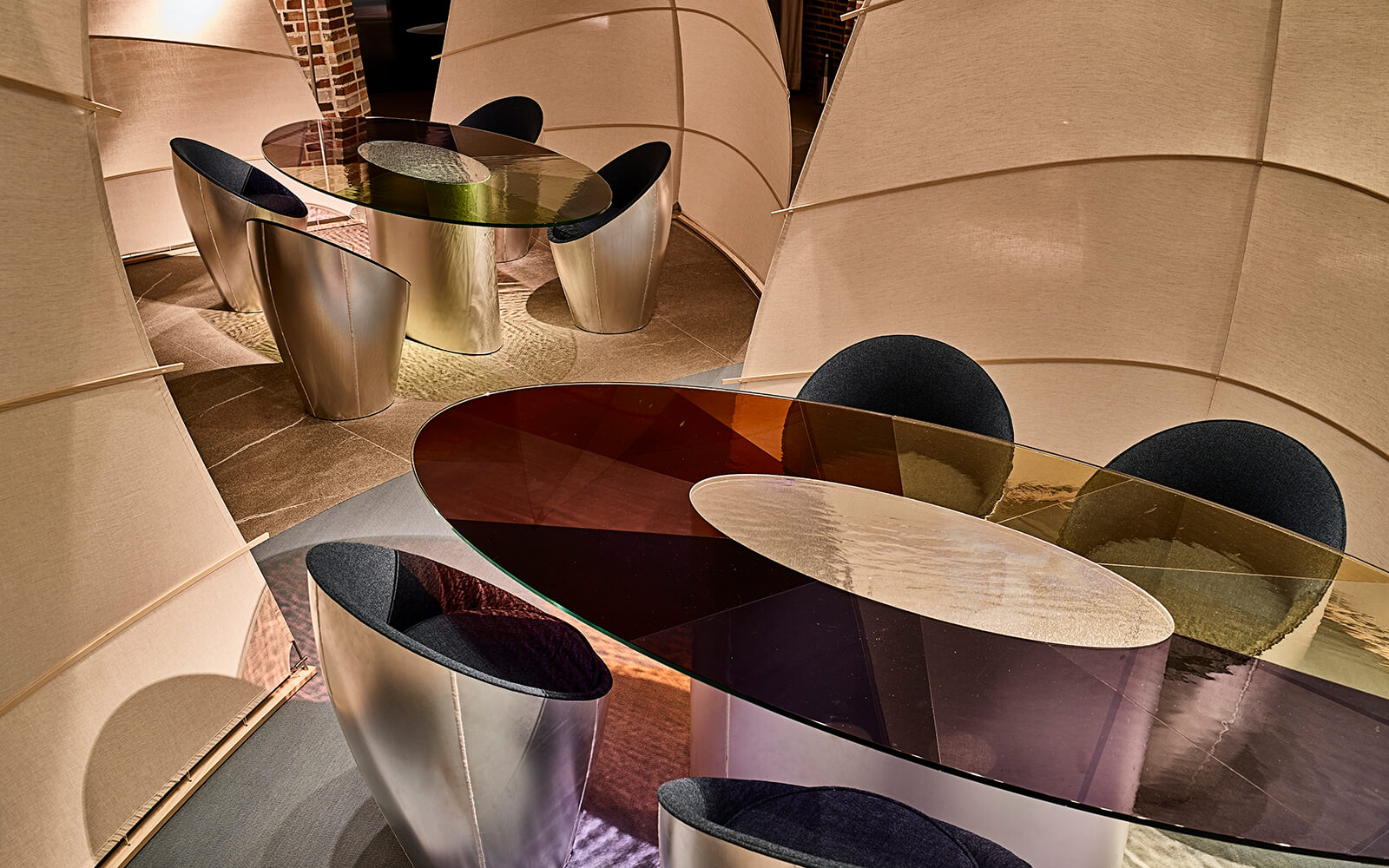Fjord House / Olafur Eliasson and Sebastian Behmann with Studio Olafur Eliasson
Fjord House / Olafur Eliasson and Sebastian Behmann with Studio Olafur Eliasson
Description
Fjordenhus (Fjord House), the first building designed entirely by artist Olafur Eliasson and the architectural team at Studio Olafur Eliasson was opened on 9 June in Vejle, Denmark. Commissioned by KIRK KAPITAL, the company’s new headquarters offer a contemporary interpretation of the idea of the total work of art, incorporating remarkable site-specific artworks by Eliasson with specially designed furniture and lighting.
Rising out of the water, Fjordenhus forges a striking new connection between Vejle Fjord and the city centre of Vejle—one of Jutland peninsula’s thriving economic hubs. As one moves from the train station towards the harbour, Fjordenhus comes into view across the expansive plaza of the man- made Havneøen (The Harbour Island), a mixed-use residential and commercial area currently in development. From here, residents and visitors can access the ground floor of Fjordenhus via a footbridge or stroll along the jetty designed by landscape architect Günther Vogt.
The building’s public, double-height entrance level is dedicated to the relation of the building to the water, drawing attention to the plane where the structure plunges beneath the surface, its curved edges framing glimpses of the surrounding shores and harbour. The building is permeated by the harbour itself, and its two aqueous zones are visible from viewing platforms. Both the architectural spaces and Eliasson’s artworks engage in a dialogue with the ever-changing surface of the water.
Formed by four intersecting cylinders, Fjordenhus soars to a height of twenty-eight metres (ninety- two feet). Rounded negative volumes have been carved from its facades of custom-glazed brick to create an extraordinary architectural statement of complex curved, circular, and elliptical forms, torqueing walls and parabolic arches. In its unique setting—a hybrid of natural and industrial- urban contexts—the building highlights Vejle’s future as a centre not just for today’s generation but also for generations to come.
Why brick
Classic Danish brick is the predominant material of the building’s inner and outer walls. The brick forms the smallest possible building unit and follows the organic shape of the building. Fjordenhus’s intricate brickwork shapes visitors’ impression of the building as they approach. From afar, the building’s surface seems orderly, but upon closer inspection, the different shapes and slightly irregular staggering of the bricks’ depth reveals a lively, organic surface.
The brickwork incorporates fifteen different tones of unglazed brick; additional colours of glazed bricks are integrated into the carved-out sections to produce colour fades – green from the bottom and blue from the top – that reflect the water and sky. In the stairwell, scattered silver bricks reflect the sunlight shining in from above. The bricks function not only aesthetically, but also technically: hollow ventilation bricks are placed throughout the walls to modulate both sound and temperature. Every corner, niche, and arc required an individual brick-laying solution; each brick was specially fit into the complex curvature of the concrete walls, the overall brickwork lying flush with the curved steel frames and glass elements of the facade.
Building
Accessible by footbridge, the twenty-eight-metre-high building is formed by four intersecting cylinders with brick facades from which ellipsoidal negative spaces were removed to create complex curved forms and arched windows.
The varying floor plans of the different levels are organised around circles and ellipses, with specially designed furniture and lights, and are connected by spiral staircases and round vestibules. The double-height ground floor, which is open to the public, is permeated by the fjord and contains two aqueous zones with site-specific artworks by Olafur Eliasson. The KIRK KAPITAL offices occupy the upper three floors. Perched atop the building is a green roof with vegetation and solar panels. By night, Fjordenhus is lit from within, resembling a lighthouse.
Setting
Vejle Fjord in Jutland stretches east from its head at the city of Vejle to its mouth at the Kattegat Sea. Fjordenhus stands in the water alongside Havneøen (The Harbour Island), a man-made island that was developed in response to a concept by Vejle Municipality to revitalise the harbour area, introducing important new residential components into a traditionally industrial environment.
For those approaching from Vejle’s main urban axis, the building appears as the focal point, surrounded by water and with the Vejle Fjord Bridge in the background. The concrete and cobblestone surfaces of the expansive plaza in front of the building are echoed in the design of Günther Vogt’s jetty, while the cylindrical forms and distinctive brickwork of Fjordenhus nod to the historical harbour typologies of warehouses and silos. Set against the backdrop of the fjord, the building itself breaks the smooth plane of the water.
Floors & Ceilings
The floors and ceilings of Fjordenhus are formed by white concrete slabs, creating spaces 3.2 metres in height on each level. They conceal the distribution of technical infrastructure such as the heating and cooling systems. The grid pattern of cut-out negative circular volumes in the ceiling reduces the overall weight of the ceiling.
These hollows also serve to hold light fixtures and modulate the acoustics of the space. Pietra Piasentina stone was used to cover all the floors. Unlike classic granite stones, Pietra Piasentina can only be found in boulders quarried from the hills of Friuli, Italy.
Windows & Doors
The double-curved, 3D-formed windows precisely follow the geometry of Fjordenhus. Steel frames span several floors of the building, while the window voids form the main element of the facade. In some areas, rotating doors were introduced to accommodate the geometrical challenges of the building’s overall shape. All of the doors and windows are tilted; by design, the walls contain no right angles.
Carpets
The kilim carpets, each with a diameter of 9.4 metres and placed in the centres of the drums, were handwoven in Varanasi, India. Looms were custom-built so the carpets could be woven seamlessly, and each carpet comes in a different monochrome colour. The smaller, elliptical entrance rooms linking the stairwells to the main office spaces are fitted with hand-tufted carpets. All the carpets have been deliberately designed to be sound-absorbant.
Furniture
The office spaces on the building’s first, second, and third floors feature several custom-made furniture pieces designed by Olafur Eliasson and Studio Olafur Eliasson.
Wood was introduced as the dominant material for the additional built-in cabinets, bathrooms, kitchens, and staircases in the private spaces.
Lighting
The lighting for the building has been custom-designed by Olafur Eliasson and Studio Olafur Eliasson. Some fixtures are freestanding, others imbedded in the structure.
All of the fixtures throughout Fjordenhus are powered by LED bulbs, and the freestanding lamps in particular have been created using handblown glass in six different colours.
Artworks
The various spaces throughout Fjordenhus contain unique artworks by Olafur Eliasson. These installations span the publically-accessible water spaces and ground floor of Fjordenhus, as well as the other floors within. Fjordhvirvel, a central piece in this body of artworks, draws in the viewer while also drawing attention to the water and weather that encircle Fjordenhus.
The spheres of Undervandsforventning and Den indre himmel visually link the lower and upper spaces and create a formal dialogue between the curvature of the building, the daily cycles of the fjord, and the arc of the sun’s path across the sky. The same is true for the light works Fjordreflektor, Fjordenhus meridian, and Cirkelspejl, which emphasise an interplay of light and surface. These pieces, enmeshed with the architecture, further the synthesis of water and light in Fjordenhus, a total work of art.
New High-end Restaurant
New high-end restaurant LYST in Fjordenhus combines food, architecture, and the elements of nature. Today, the much-anticipated restaurant LYST opens in the iconic Fjordenhus building in Vejle, Denmark. The restaurant is owned by Morten Kirk Johansen, who is one of the heirs of the famous Lego group.
Together with his team of chefs and sommeliers he has developed LYST in close collaboration with Studio Other Spaces (SOS), the office for art and architecture co-founded by Olafur Eliasson and Sebastian Behmann. For LYST, the architecture of the building acted as a catalyst of the cuisine, and the food, in turn, inspired the interior design of the restaurant. SOS developed the interior design, including furniture, lighting, and eating utensils, to emphasise the relationship between the fjord, the building, the food, and the people using the space. Through several interdisciplinary workshops with Morten Kirk Johansen, chef Daniel McBurnie, and his dedicated kitchen team, SOS formulated a design language based on basic materials and production methods, and the way cooking with simple ingredients can achieve unique results.
www.restaurantlyst.com
Instagram: @restaurantlyst
”When you eat at LYST, the fjord flows through you – through the fish that swam there, the produce from local farms, through the game and foraged herbs and mushrooms from the forests, and through the very design of each element of the restaurant. LYST grew from the convergence of food, architecture, interior, utensils, and people.” - Olafur Eliasson
”The design elements at LYST were inspired by the way the kitchen team uses simple ingredients and cooking techniques to create the menu. For instance, the chairs have been hydroformed with water pressure, similarly to how the Indian bread Poori served at LYST is given shape by hot air. We used raw materials like glass, steel and ceramics, as well as basic transformation techniques, to make the design process visible: for the guest to experience the transformation of ingredients and materials to food and design.” - Sebastian Behmann
A word from the Artist
"Fjordenhus has been an exciting opportunity for us to bring years of research in diverse fields – urban space, light conditions, nature, physical movement, how we use our senses – together in one project that truly melds artistic and architectural vision.
In the design team, we experimented from early on with how to create an organic building that would respond to the ebb and flow of the tides, to the shimmering surface of the fjord, and to the ephemeral qualities of daylight, changing at different times of the day and of the year.
Fundamental to the concept of Fjordenhus is the notion that there is no one ideal position from which to view the building. As you move around and through the structure, your perception of space changes continuously, constantly defined and redefined by your movement. It is the time it takes you to pass into or through the building that defines your experience of space. The level floor grounds you, but at the same time, the walls curve, lean in or out, and perpetuate a sense of movement. Every line seems negotiable, depending on where you are – your movement makes the building soft; it gives you agency.
Another key element of this project was to create the most immediate relation between a building and its environment. The outer walls, which are normally seen as a membrane between inside and outside, are spaces in Fjordenhus – sometimes the spaces are part of the interior and other times they open to the surroundings as balconies. And there is a porosity to the building: while it stands directly in the water, which permeates parts of the ground floor, the building is shot through with many different openings that frame views of the fjord and the natural elements, which makes the presence of nature felt.
More relational than monumental, Fjordenhus is co-created by its shifting fjord context as well as by the people experiencing it. It makes you conscious of your own presence – conscious not only that you are seeing the building, but that the building is also seeing you." – Olafur Eliasson, artist
A word from the Architect
"When the Kirk Johansen family asked us to design their new headquarters we embraced the challenge to define a building right at the heart of what matters most to Vejle: the fjord. We planned the building as a central element of the harbour, a structure set between the city and the water. We wanted to create a strong connection to this setting, whether it was seen from the city centre or from the surrounding hills, whether from Vejle Fjord Bridge or from boats entering the harbour.
The building honours its unique setting in a direct, radical way. Instead of just being beside the water, it is placed directly in the water. Visitors can engage with all of the site’s natural elements – water, light, wind, sound. For those approaching from Vejle’s main urban axis, the building appears as the focal point, surrounded by water and with the spectacular bridge in the background. Following the harbour edge, they reach a generously proportioned plaza that separates the building on one side from new apartment blocks on the other. Set against the backdrop of the fjord, the building itself breaks the smooth plane of the water. The basic form of Kirk Kapital’s headquarters was inspired by the harbour’s surrounding architecture. We carved precise volumes out of the building’s massive brick cylinders, subtracting the interior space out of the overall volume. These negative volumes form the elliptical cuts in the facade and act as independent spaces. The windows, normally seen as separating inside from outside, are a singular design feature of Fjordenhus. The vertical spaces within these soaring carved voids connect sky to water.
Designing a structure of this scale and purpose was like developing characters in a play or novel; we considered the relation of the elements to each other, the setting, the overall story we wanted to tell. We carefully balanced the characters. So many elements interact with each other here, from Olafur Eliasson’s artworks to the views out over the fjord, from the bricks themselves to the luminous, metal- cast stairwells; from the lighting and furnishings to the harbour setting. Now it is Fjordenhus itself that will carry the narrative into the future." – Sebastian Behmann, architect
Extra Info
Olafur Eliasson:
Artist Olafur Eliasson (Iceland/Denmark), born in 1967, works in a wide range of media, including
installation, painting, sculpture, photography, and film. Since 1997, his solo shows have appeared
in major museums around the world. As part of his practice, he engages with arts education,
policy-making, and issues of sustainability and climate change. Eliasson’s architectural projects
include the Serpentine Gallery Pavilion 2007, designed together with Kjetil Thorsen; Your rainbow
panorama, a 150-metre circular, coloured-glass walkway situated on top of ARoS Aarhus Art
Museum, Denmark (2006–11); and Harpa Reykjavik Concert Hall and Conference Centre (2005–
11), which won the Mies van der Rohe Award in 2013 and for which Eliasson created the facades in
collaboration with Henning Larsen Architects.
www.olafureliasson.net
Sebastian Behmann:
Architect Sebastian Behmann, born in Germany in 1969, has worked with Olafur Eliasson since 2001 and is head of the department of design at Studio Olafur Eliasson, as well as co-founder of Studio Other Spaces. Major projects with Eliasson include the Serpentine Gallery Pavilion 2007 in London, Cirkelbroen (The circle bridge) in Copenhagen (2015), and Fjordenhus in Vejle, Denmark (2009–18), in addition to numerous installations, pavilions, and international exhibitions.
About Studio Olafur Eliasson:
The team at Studio Olafur Eliasson consists of over one hundred people, from craftsmen and specialised technicians to architects, archivists, researchers, art historians, cooks, and administrators. They work with Eliasson to develop, produce, and install artworks, projects, and exhibitions, as well as on experimentation, archiving, research, publishing, and communications. In addition to realising artworks in-house, Eliasson and the studio work with structural engineers and other specialists and collaborate worldwide with cultural practitioners, policymakers, and scientists.
DESIGN TEAM
| Artist: | Olafur Eliasson |
| Architectural Design: | Sebastian Behmann with Studio Olafur Eliasson |
| Project Architects: | Caspar Teichgräber (2013-2018), Ben Allen (2012-2013), Felix Hallwachs (2011-2012), Ricardo Gomes (2009-2011) |
| Design and Site Supervision: | Reinhard Ostendorf |
| Design and Production Supervision: | Ilja Leda |
| Geometry: | Phillip C. Reiner |
| Visualisation: | Robert Banovic |
Studio Olafur Eliasson Team for Fjordenhus:
Nestor Perez Batista, Theis Bloch, Sylvain Brugier, Jan Bünnig, Ruben Bygvraa, Bendix Carabetta, Michelle Chen, Michel David, Heide Deigert , Taylor Dover, Jesper Dyrehauge, Anna Engberg-Pedersen, Emilie Engbirk, Martin Enoch, Sophie Erlund, Noel Fäh, Laura Freiling, Matthias Gerber, Yolandé Gouws, Maria Björk Gunnarsdóttir, Thomas Blumtritt Hanisch, Jennifer Hauger, Frank Haugwitz, Friedrich Herz, Erik Huber, Jöran Imholze,Holger Jenal, Ruben Jodar, Lisa Jugert, Roger Kaiser, Camilla Kragelund, Inga Krieger, Al Laufeld, Gianna Ledermann, Sharron Lee, Meng Li, Luca Longagnani, Lars Lubnau, Julia Lutz, Margaret Lutz, Riccardo Mariano
KEY DATES
| Concept Phase: | 2009–2011 |
| Design Phase: | 2011–2013 |
| Building Phase: | 2013–2018 |
| Inaugeration: | 9 June 2018 |
DESIGN
| Artist: | Olafur Eliasson |
| Architectural Design: | Sebastian Behmann with Studio Olafur Eliasson |
| Project Architect: | Caspar Teichgräber |
| LOCAL ARCHITECT: | Lundgaard & Tranberg Architecture |
| LANDSCAPE ARCHITECT: | Vogt Landscape Ltd. |
| CLIENT: | KIRK KAPITAL A/S |
PROJECT MANAGEMENT
| Project Manager: | Flemming Hoff Jakobsen, Hundsbæk & Henriksen A/S |
| Construction Manage: | Jørn Andreasen, Hundsbæk & Henriksen A/S |
CONSULTANTS
| Technical Supervision: | Hundsbæk & Henriksen A/S |
| Engineering: | Cowi A/S |
| Environmental Engineering: | Transsolar Energietechnik GmbH |
| Consulting Engineering: | ArtEngineering GmbH |
| Acoustic Engineering: | Gade & Mortensen Akustik A/S |
| Fire Counseling: | Hundsbæk & Henriksen A/S |
| Safety: | Eggersen Miljø & Sikkerhed APS |




